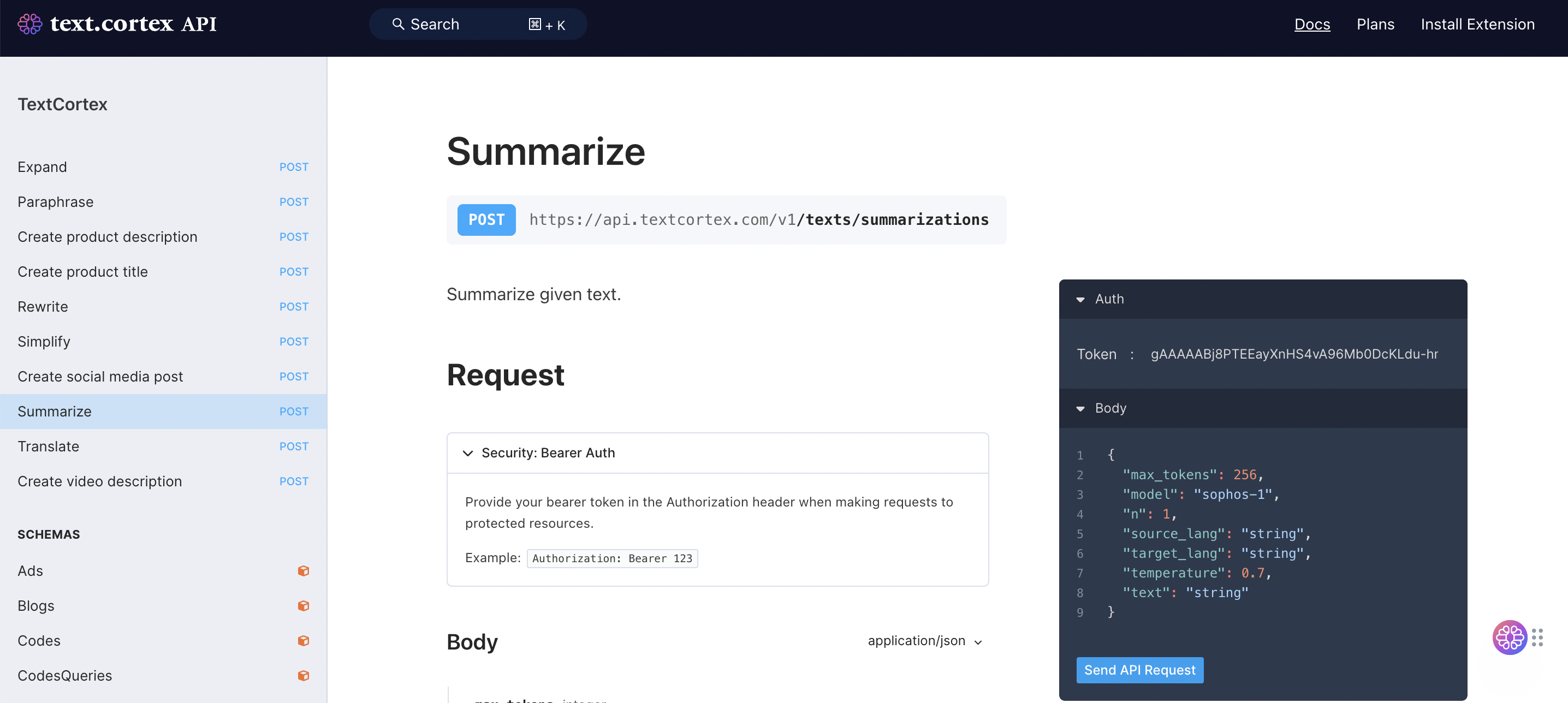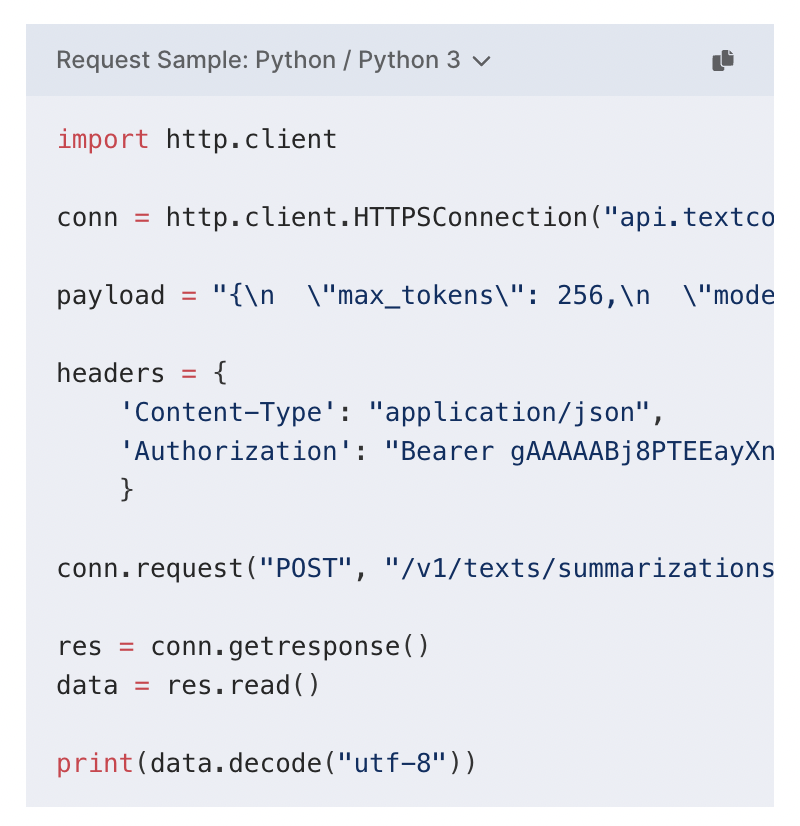Natural Language Processing involves analyzing text or speech to extract meaning from it, and then taking action based on that meaning. NLP techniques are used in many applications, such as machine translation, automatic summarization, question answering systems, information retrieval systems, text classification and more. In this context, we will be closely reviewing our Text Summarization endpoint within our NLP API.
About Natural Language Processing APIs
Natural language processing APIs are machine learning tools that have been pre-trained to evaluate the tone of text, as well as analyze syntax, identify entities, and classify content. This technology allows developers to comprehend and extract relevant information from any text they're working with in order to determine customer sentiment or gain insights into conversations online related to their product or service. NLP is a field that combines machine learning, computer science, and linguistics.
Brief History of Natural Language Processing
Natural language processing (NLP) is the process of understanding, analyzing, and generating natural language. It has been around since the 1950s when computer scientists began to explore ways to make computers understand human languages. Since then, NLP has evolved in leaps and bounds with the development of more sophisticated algorithms and powerful computing resources such as neural networks. Today, NLP is used in a wide range of applications such as chatbots, search engines, automatic translation services, and digital assistants like Alexa or Siri.
How Do Natural Language Processing APIs Work?
Natural language processing (NLP) APIs are a kind of AI which allows computers to comprehend human language. This is realized through various approaches like text analysis, categorization, and natural language understanding. Generally speaking, NLP APIs take in text such as a sentence or paragraph then output results that contain the meaning of the text, its sentiment or emotionality, along with other data.
Why are NLP APIs important?
NLP APIs are necessary for the integration of natural language processing software into existing systems. This software permits developers to analyze and classify text quickly and accurately, surpassing human capacity. Once added to a system, it can be used for a variety of purposes such as understanding customer sentiment, gaining UX insights, and connecting requests to payment proofs.
TextCortex’s NLP API for Text Summarization
Are you looking for a Natural Language Processing API for Text Summarization you can straight integrate into your existing software architecture? Please be our guest, grab yourself a drink and check out our Text Summarization API powered by Transformer models.
Our Documentation: https://docs.textcortex.com/api/paths/texts-summarizations/post
API Overview: https://textcortex.com/text-generation-api
Sign up and get instant free credits to try our API. (Go to your Account Settings to generate your API Key after you've logged in.)
How does TextCortex API work?
Text summarization simply is the process of summarizing a block of text in order to make it shorter.

Let's say you have the following block of text:
Generative Pre-trained Transformer 3 (GPT-3) is an autoregressive language model released in 2020 that uses deep learning to produce human-like text. Given an initial text as a prompt, it will produce text that continues the prompt. The architecture is a decoder-only transformer network with a 2048-token-long context and then-unprecedented size of 175 billion parameters, requiring 800GB to store. The model was trained using generative pre-training; it is trained to predict what the next token is based on previous tokens. The model demonstrated strong zero-shot and few-shot learning on many tasks. The successor to GPT-2, GPT-3 is the third-generation language prediction model in a GPT series created by OpenAI, a San Francisco-based artificial intelligence research laboratory. GPT-3, which was introduced in May 2020, and was in beta testing as of July 2020, is part of a trend in natural language processing (NLP) systems of pre-trained language representations.
A summarization model would return something like this:
GPT-3 is the third-generation language prediction model released by OpenAI in 2020. It is an autoregressive language model with a decoder-only transformer network, a 2048-token context, and 175 billion parameters requiring 800GB to store. It was trained using generative pre-training to predict what the next token is based on previous tokens and has demonstrated strong zero-shot and few-shot learning on many tasks.
You can integrate these models into your own systems and make use of generative AI capabilities to provide a seamless experience for your users. Once you are connected to our API, the only thing you need to is to send a POST request with the required information needed to create a summary for.

Why Use Summarization API?
Text summarization can be usefully used in many situations. Let's give you a couple of examples for real life uses.
News Review
Those responsible for marketing and commercial roles often have to dedicate a considerable amount of time to reading the news. Utilizing summarized material can help them conserve both their energy and precious hours.
Content Creation
When businesses are producing multiple pieces of content regularly, it is likely they will need to condense each article into a headline or summary so that it can be shared on social media channels.
Legal Document Parsing
Automating the process of reading and understanding legal documents can be a great way to save time. Instead of having to read through all the details, people could get a summary of what was included in the document.
Reports Generation
Additionally, summarization can help with generating reports that may be required for customers, management, or coworkers.
Sign up and get instant free credits to try our API. (Go to your Account Settings to generate your API Key for free after you've logged in. We give $5 credits.)

%20(18).png)
%20(7).png)
%20(6).png)
%20(5).png)